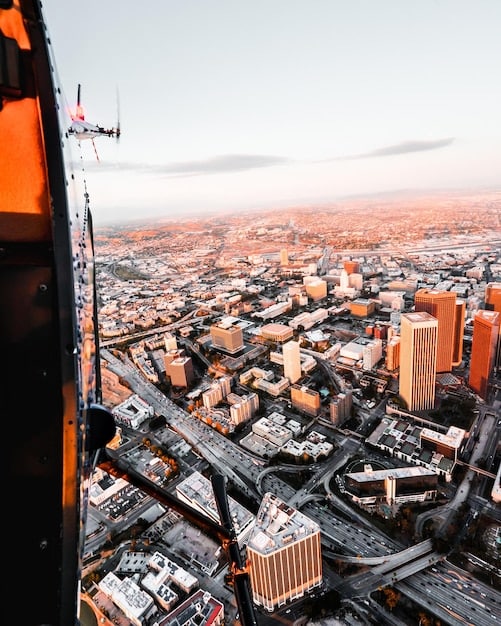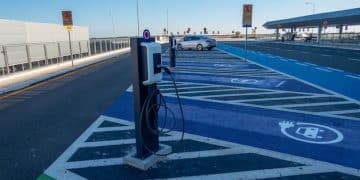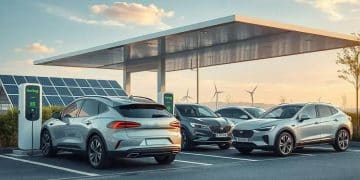Urban Air Mobility Trends: Impact on US Cities by 2025

Emerging trends in Urban Air Mobility (UAM) by 2025 include advancements in electric vertical takeoff and landing (eVTOL) aircraft, the development of UAM infrastructure like vertiports, and the integration of UAM into existing urban transportation networks, which could significantly impact US cities by providing faster, more efficient, and sustainable transportation options.
The future of urban transportation is rapidly evolving, and one of the most exciting frontiers is what are the emerging trends in Urban Air Mobility (UAM) and their potential impact on US cities by 2025?
Understanding Urban Air Mobility (UAM)
Urban Air Mobility (UAM) is an innovative concept that seeks to revolutionize how people and goods move within and around cities. It envisions a network of on-demand, automated aircraft providing safe, efficient, and convenient transportation services.
Key Components of UAM
Several key components are essential for the successful implementation of UAM systems.
- eVTOL Aircraft: Electric Vertical Takeoff and Landing (eVTOL) aircraft are at the heart of UAM, offering the ability to take off and land vertically, eliminating the need for traditional runways.
- Vertiports: Vertiports are designated areas for eVTOL aircraft to take off, land, and recharge. They will be strategically located throughout urban areas to provide easy access to UAM services.
- Air Traffic Management (ATM): Advanced ATM systems are crucial for managing the flow of air traffic in UAM networks, ensuring safety and efficiency.
- Regulations and Standards: Clear regulations and safety standards are necessary to govern UAM operations and ensure public trust.
The development and integration of these components are crucial for realizing the full potential of UAM.
In addition to these core elements, public acceptance and infrastructure investments are also vital for the widespread adoption of UAM.

UAM aims to alleviate traffic congestion, reduce commute times, and improve overall quality of life in urban areas by introducing a new dimension to transportation.
Emerging Trends in UAM Technology
The technological landscape of UAM is rapidly evolving, with several key trends shaping its future.
Advancements in eVTOL Technology
Electric Vertical Takeoff and Landing (eVTOL) aircraft are at the forefront of UAM innovation. Significant advancements are being made in battery technology, propulsion systems, and aircraft design, leading to increased range, payload capacity, and efficiency.
Many companies are experimenting with different eVTOL configurations, including multi-rotor, lift-plus-cruise, and vectored thrust designs, each offering unique advantages in terms of performance and operational capabilities.
Autonomous Flight Capabilities
Autonomous flight technologies are also playing a crucial role in UAM development. As regulations evolve, autonomous or remotely piloted eVTOLs can enhance safety, reduce operating costs, and improve the overall scalability of UAM systems.
These advancements include:
- Improved Sensors: Advanced sensor technologies, such as LiDAR and radar, provide eVTOL aircraft with accurate situational awareness.
- AI-Powered Navigation: Artificial Intelligence (AI) algorithms enable autonomous navigation and decision-making.
- Remote Piloting Systems: Remote piloting systems allow ground-based operators to monitor and control eVTOL aircraft remotely.
Overall, autonomous flight technologies enable UAM systems to operate efficiently, safely, and at scale, which is essential for integrating UAM into existing transportation networks.
These advancements promise to transform urban transportation, providing new, efficient ways to move people and goods within cities.

UAM Infrastructure Development in US Cities
The development of UAM infrastructure is crucial for the successful integration of air mobility services into US cities. This includes the planning, design, and construction of vertiports, as well as the integration of UAM into existing transportation networks.
Vertiport Planning and Design
Vertiports are essential for UAM operations, providing designated areas for eVTOL aircraft to take off, land, and recharge. Their design and location impact the efficiency and accessibility of UAM services.
Factors influencing vertiport planning and design include:
- Location: Vertiports should be located in strategic locations, such as transportation hubs and urban centers.
- Capacity: Vertiports must have enough capacity to accommodate the expected volume of UAM traffic.
- Safety: Vertiports should be designed with safety in mind, incorporating features such as fire suppression systems and emergency landing areas.
Integration with Existing Transportation Networks
Integrating with existing transportation involves connecting vertiports to other modes of transportation, creating seamless multimodal travel experiences. This includes:
- Public Transit: Connecting vertiports to subway stations and bus terminals to provide convenient transfers.
- Ride-Sharing Services: Partnering with ride-sharing companies to provide door-to-vertiport transportation options.
- Parking Facilities: Locating vertiports near parking facilities to serve commuters and travelers.
Successfully implementing vertiports requires collaboration between government entities, private companies, and community stakeholders to address safety, sustainability, and integration into urban planning.
Smart urban planning and creative infrastructure solutions are necessary to maximize UAM’s potential while minimizing disruptions.
Potential Impact on US Cities by 2025
The emergence of UAM has the potential to significantly transform US cities by 2025. By providing a new mode of transportation, UAM can alleviate traffic congestion, reduce commute times, and improve overall quality of life.
Reduced Traffic Congestion
One of the most significant potential benefits of UAM is its ability to alleviate traffic congestion in urban areas. By moving passengers and goods through the air, UAM can bypass congested roadways and reduce the strain on existing transportation infrastructure.
By reducing congestion, UAM can help to improve air quality and reduce greenhouse gas emissions, contributing to a more sustainable urban environment. Additionally, decreased congestion can lead to time and cost savings for businesses and individuals.
To maximize its potential, UAM must:
- Integrate with Existing Networks: Seamless connections with traditional ground transportation are essential.
- Achieve Public Acceptance: Gaining public trust through safety and noise reduction measures is key.
- Promote Equitable Access: Ensuring that UAM services are available to all residents, not just the affluent.
Overall, the potential for UAM to improve the lives of city dwellers makes it an exciting field to watch.
By addressing these challenges, US cities can fully realize the potential benefits of UAM.
Regulatory and Societal Challenges
While UAM offers many exciting possibilities, it also presents significant regulatory and societal challenges that must be addressed to ensure its safe and successful implementation.
Safety and Security Concerns
Ensuring safety and security is of paramount importance in UAM. This includes:
- Air Traffic Management: Developing advanced systems to manage air traffic and prevent collisions.
- Aircraft Certification: Establishing rigorous certification standards for eVTOL aircraft.
- Cybersecurity: Protecting UAM networks from cyber threats and ensuring data privacy.
Public Acceptance and Noise Concerns
Gaining public acceptance is crucial for the success of UAM. This involves addressing concerns about noise pollution, safety, and visual impact. Cities should:
- Conduct Public Outreach: Educate the public about the benefits and risks of UAM.
- Implement Noise Reduction Measures: Use noise-reducing technologies in vertiports and eVTOL aircraft.
- Engage with Communities: Work with local communities to address their concerns and incorporate their feedback into UAM planning.
Effective communication, robust safety measures, and responsible noise management are vital for integrating UAM successfully into urban environments.
Overcoming these obstacles will pave the way for a future where UAM contributes positively to the urban landscape.
The Future of Urban Air Mobility
Looking ahead, the future of Urban Air Mobility (UAM) holds immense promise. As technology continues to advance and regulations evolve, UAM has the potential to transform the way people and goods move within and around cities.
Long-Term Vision for UAM
The long-term vision includes autonomous eVTOL fleets, seamless multimodal integration, and sustainable operations. These advancements will require breakthroughs in battery technology, autonomous systems, and air traffic management.
- Wider Adoption: The use of UAM expands to more cities and regions, improving connectivity and reducing commute times.
- Enhanced Efficiency: Continual improvements in technology result in faster, more efficient, and more sustainable UAM operations.
The Role of AI and Big Data
AI and big data will play a crucial role in optimizing UAM operations. AI algorithms can be used to optimize flight paths, predict demand, and improve safety. Big data analytics can provide valuable insights into travel patterns and preferences, enabling service providers to tailor their offerings to meet the needs of customers.
Innovative approaches, community involvement, and strategic planning are essential to unlock UAM’s transformative potential.
By embracing these innovations, cities can create more sustainable, efficient, and livable urban environments.
| Key Point | Brief Description |
|---|---|
| 🚀 eVTOL Advancements | Improved battery tech & autonomous capabilities enhance UAM efficiency. |
| 🏙️ Vertiport Integration | Vertiports connect UAM to existing transit networks for seamless travel. |
| 🚦 Reduced Congestion | UAM alleviates ground traffic, saving time and reducing emissions in cities. |
| 🛡️ Safety & Regulations | Strict safety standards and regulations are essential for UAM adoption. |
Frequently Asked Questions (FAQ)
▼
Urban Air Mobility (UAM) refers to the use of aircraft, such as electric vertical takeoff and landing (eVTOL) vehicles, to transport people and goods within urban areas, aiming to improve transportation efficiency and reduce congestion.
▼
UAM has the potential to significantly reduce traffic congestion by providing an alternative mode of transportation that operates above ground, bypassing congested roadways and reducing the strain on existing infrastructure.
▼
Vertiports are designated areas for eVTOL aircraft to take off, land, and recharge. They are crucial infrastructure components for UAM, providing safe and efficient locations for UAM operations within urban environments.
▼
Key safety concerns include ensuring air traffic management to prevent collisions, establishing rigorous certification standards for eVTOL aircraft, and protecting UAM networks from cyber threats to maintain data privacy and operational security.
▼
AI will play a crucial role in optimizing UAM operations by improving flight path efficiency, predicting demand for services, enhancing safety through autonomous systems, and personalizing the user experience with data-driven insights.
Conclusion
As we look to the future, the emerging trends in Urban Air Mobility promise to reshape transportation in US cities by 2025. With advancements in eVTOL technology and vertiport infrastructure, UAM offers a potential solution to reduce traffic congestion, improve transportation efficiency and positively transform urban living.





